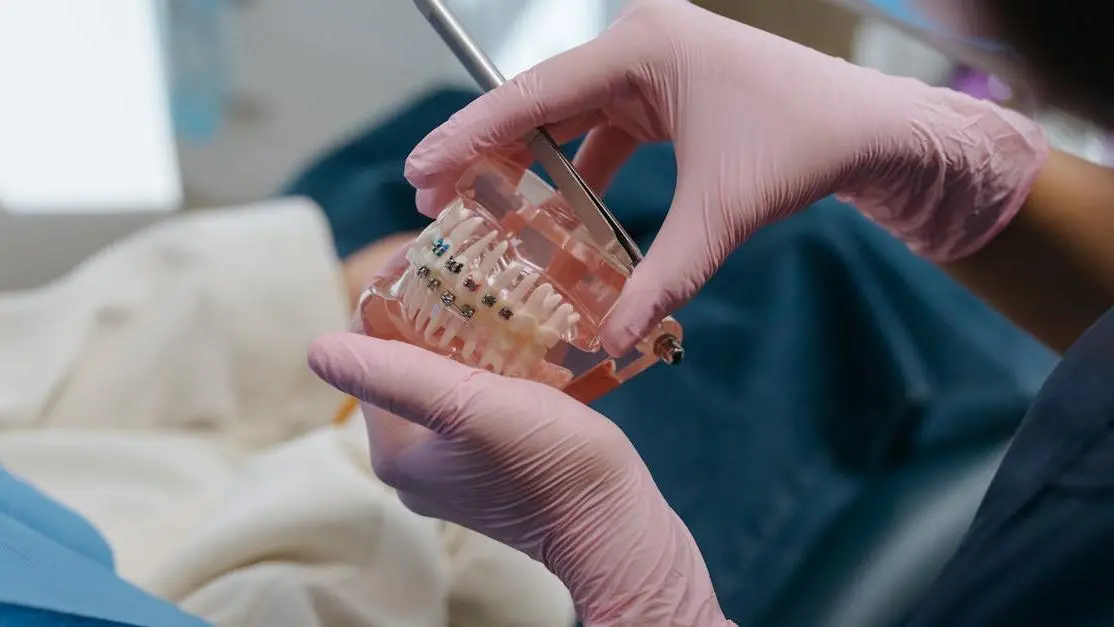Maintaining oral hygiene for braces can be a challenging and overwhelming experience, especially when ensuring comfort and dental health during your orthodontic journey.
We understand your concerns, which is why our guide is designed to make the process easier. Here's what you'll find:
- Tips to master oral hygiene for braces while keeping your teeth and gums healthy.
- Advice on choosing the right toothbrush and toothpaste for optimal cleaning.
- Practical brushing techniques tailored for braces wearers to reduce discomfort and improve results.
Why Is Oral Hygiene Crucial for Braces Wearers?
When it comes to wearing braces, oral hygiene isn't just important—it's crucial. At Cookstown Dental Centre, we understand how vital it is to keep your mouth clean and healthy throughout your orthodontic journey. But why is this so essential, especially when you have braces?
Braces are incredible tools for straightening your teeth and improving your smile, but they also create extra nooks and crannies in your mouth. These spaces can easily trap food particles and harbor harmful bacteria, leading to plaque buildup. Without proper care, this can cause cavities, gum inflammation, or even prolong your treatment time.
- Prevent Plaque Buildup: Braces provide more surface area for plaque to gather, making your teeth more prone to decay.
- Support Effective Treatment: Clean teeth lead to more effective orthodontic treatment and a shorter time wearing braces.
- Avoid Gum Issues: A good oral hygiene routine can help prevent gingivitis and maintain healthy gums.
Our team is here to guide you through maintaining excellent oral health while wearing braces. It's about keeping your teeth in top shape, so you see the best results when your braces come off.
How to Choose the Right Toothbrush and Toothpaste for Braces
Selecting the right toothbrush and toothpaste can make all the difference in maintaining good oral hygiene with braces. You might wonder, "Does it really matter?" The answer is a resounding yes!
When you're brushing with braces, you need a tool that can navigate the intricate spaces around the brackets and wires effectively. Here's what you should look for:
- Soft-Bristled Toothbrush: Using a toothbrush with soft bristles minimizes irritation to your gums and prevents damage to the brackets.
- Electric Toothbrush Option: Electric toothbrushes can be particularly effective. Those with rotating heads help enhance cleaning efficiency around the braces.
- Fluoride Toothpaste: It’s essential to use fluoride toothpaste to protect against cavities, as maintaining cavity-free teeth is a priority when wearing braces.
By understanding the importance of the right dental care tools, you can significantly improve your brushing routine, keeping your teeth and braces sparkling clean.
Brushing Techniques That Work Best with Braces
Brushing your teeth with braces requires a bit more technique than usual, but with a few adjustments, it can become second nature. Here are some step-by-step tips to make your brushing routine effective:
- Position the Brush at a 45-Degree Angle: Start by placing your toothbrush at a 45-degree angle to the gum line. This helps clean both the surface of the braces and the gum area.
- Brush with a Circular Motion: Gently move the toothbrush in small circles to ensure you're covering all surfaces, especially around the brackets and wires.
- Focus on Each Tooth: Pay extra attention to every tooth, brushing each area for about 10 seconds to thoroughly remove all food particles and plaque.
- Brush After Every Meal: Aim to brush at least three times a day—ideally after each meal—to prevent food buildup.
- Duration Matters: Ensure each brushing session lasts for at least 3 minutes to maximize effectiveness.
These techniques are crucial for maintaining oral hygiene and ensuring comfort while wearing braces. Keep your smile bright and healthy by sticking to these tried-and-true methods.
The Importance of Flossing and How to Do It with Braces
Flossing with braces can seem like a daunting task, but it's an essential part of your oral hygiene routine. While it may require a bit more effort, using the right tools can ease the process considerably. Let’s talk about how you can make flossing with braces less challenging:
- Floss Threaders: This simple tool helps guide the floss between your braces and teeth. It allows you to reach those tricky spots that brushing might miss.
- Water Flossers: Also known as oral irrigators, these devices use a stream of pulsating water to remove food particles and plaque between teeth. They're effective and much easier to use for brace wearers.
- Regular Waxed Floss: If you prefer traditional floss, waxed floss is less likely to shred or get caught on your braces.
Here's a step-by-step guide to flossing with braces:
- Floss Threader: Insert a piece of floss into the floss threader.
- Thread the Floss: Carefully thread the floss behind the main wire of your braces, ensuring it reaches between the teeth.
- Floss Between Teeth: Use a gentle sawing motion to move the floss up and down along the sides of both teeth.
- Repeat for Each Tooth: Continue this process for all your teeth, being extra gentle around the braces to avoid discomfort.
Regular flossing is key to maintaining healthy gums and teeth during orthodontic treatment. By integrating these methods into your routine, you're on the path to achieving excellent oral hygiene with braces.
Foods to Avoid and Safe Eating Practices
Keeping your braces and mouth in top shape requires a little extra thought when it comes to what you eat. Some foods are best left off your plate, while others can be enjoyed with just a bit of modification. Let's chat about the food dos and don'ts while you're on your orthodontic journey.
- Avoid Sticky and Chewy Foods: Things like caramel, taffy, and chewing gum can cling to braces and are difficult to clean off.
- Skip Hard and Crunchy Snacks: Popcorn, nuts, and hard candies are tough on brackets and wires. Biting into these treats can lead to unexpected visits to our dental office for repairs!
- Careful with Sugary and Acidic Foods: Sodas, candies, and citrus fruits should be consumed sparingly as they increase the risk of cavities.
On the brighter side, sticking with softer foods and slightly adjusting how you consume favorites helps to keep your treatment on track:
- Eat Fruits and Vegetables, with Care: Cut apples into slices and steam vegetables until soft to protect your braces.
- Choose Dairy Products: Cheese, yogurt, and milk are gentle on braces and good for oral health.
- Opt for Soft Proteins: Cooked chicken, meatloaf, and fish are excellent choices.
These simple dietary choices will make your life with braces much easier, supporting both your oral health and your treatment progress.
What Are the Benefits of Regular Dental Checkups for Braces Wearers?
Regular visits with our dental professionals aren't just about keeping your treatment on schedule—they’re vital for your overall oral health while wearing braces. At Cookstown Dental Centre, we believe in creating a positive, worry-free experience for our patients.
- Professional Cleanings: Our team ensures your teeth remain free from plaque and tartar, which are potential risks when wearing braces.
- Preventive Monitoring: Regular appointments allow us to catch any issues early on, making minor adjustments to avoid prolonged treatment times.
- Comfort Management: We can address any discomfort you may experience, making your braces journey as smooth as possible.
Regular dental checkups play a crucial role in achieving the best results from your orthodontic treatment and maintaining your oral health. We’re committed to ensuring that every visit is tailored to your needs, so you leave our practice feeling confident and cared for.
Practical Tips for Managing Discomfort with Braces
Living with braces shouldn't mean living with discomfort. We have some practical tips to help you navigate any challenges:
- Utilize Orthodontic Wax: Deploy wax over any sharp brackets or wires causing irritation. It’s a quick and effective solution!
- Consider Over-the-Counter Pain Relievers: If you feel discomfort after adjustments, medications like ibuprofen can offer relief.
- Try Soothing Mouth Rinses: Warm salt water rinses help reduce inflammation and are soothing for your gums.
- Stick to Soft Foods Post-Adjustment: Smoothies, mashed potatoes, and soups are kind to your teeth and gums after a visit.
Our aim is to provide you with a pain-free braces experience. If discomfort persists, don't hesitate to reach out to us.
How Can Advanced Dental Technologies Aid in Oral Hygiene?
Incorporating state-of-the-art technologies into our dental care means more than just keeping up with trends—it’s about enhancing your experience. At Cookstown Dental Centre, modern dental technologies are game-changers for maintaining oral hygiene with braces.
- Digital Imaging: This offers precise diagnostics, ensuring meticulous monitoring of your orthodontic progress.
- CAD/CAM Technology: Provides accurate fittings for your braces, making it a seamless process.
- 3D Imaging and Intraoral Mapping: These techniques boost treatment effectiveness and patient comfort by delivering exact measurements.
We integrate cutting-edge advancements into our treatments and ensure you receive the best care possible. This commitment allows us to offer high-quality, personalized dental care you can count on.
Conclusion: Commitment to a Pain-Free Braces Experience
Maintaining great oral hygiene with braces involves choosing the right foods, sticking with a solid oral care routine, and benefiting from the latest dental technologies. Our mission is to support you through this exciting journey to achieve a confident smile with personalized and exceptional care. We encourage you to reach out to Cookstown Dental Centre for any questions, support, or to explore the advanced, pain-free care options we provide in Cookstown and surrounding communities.

